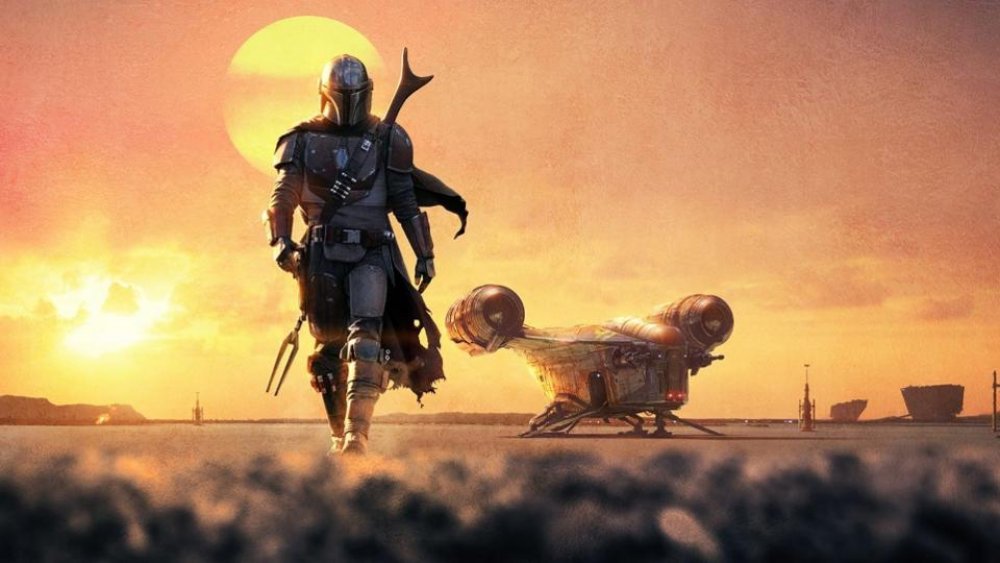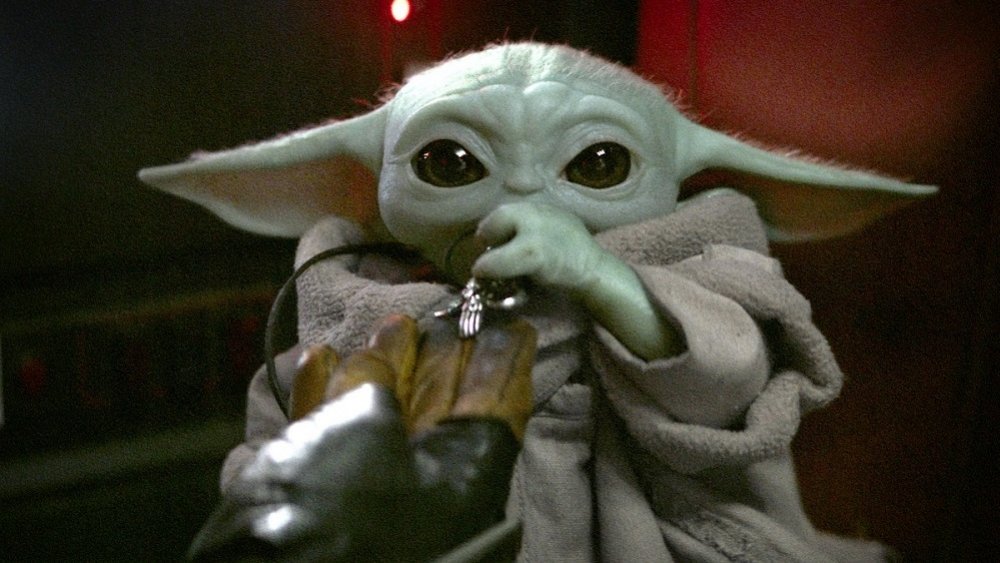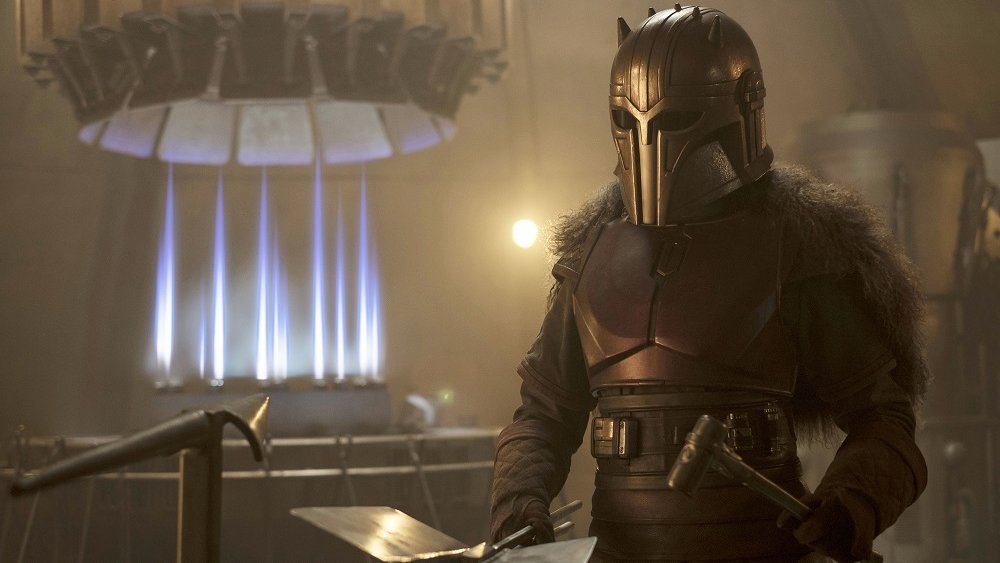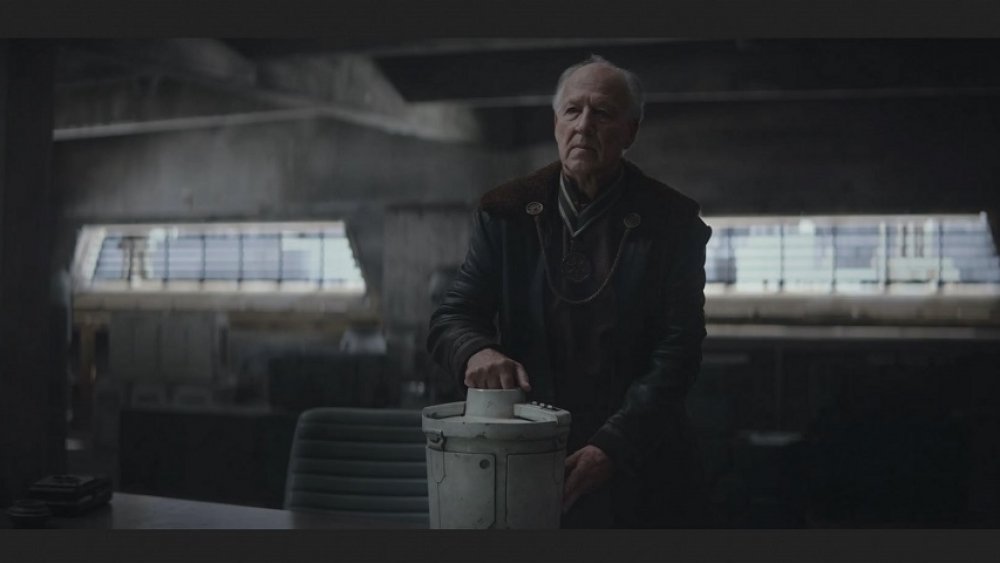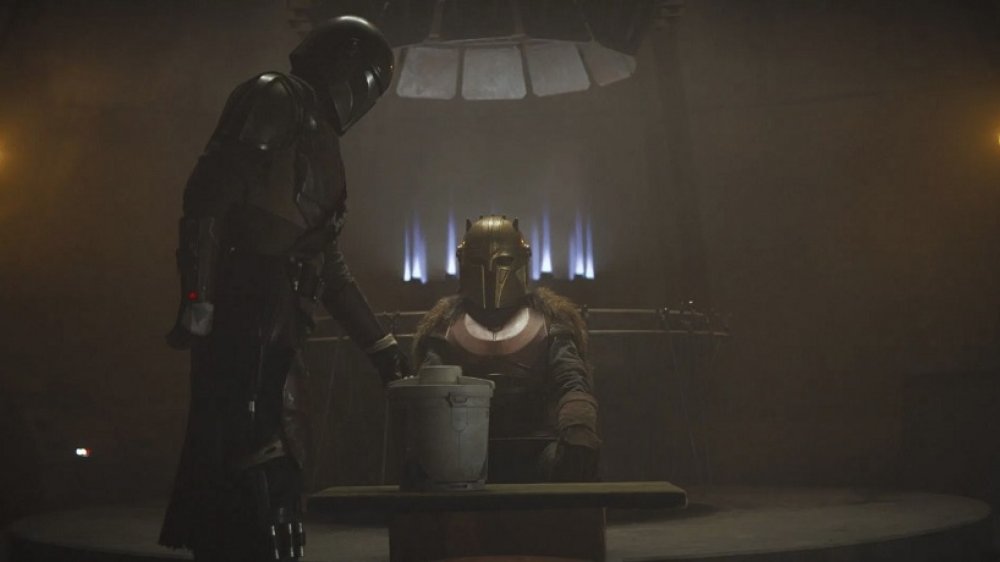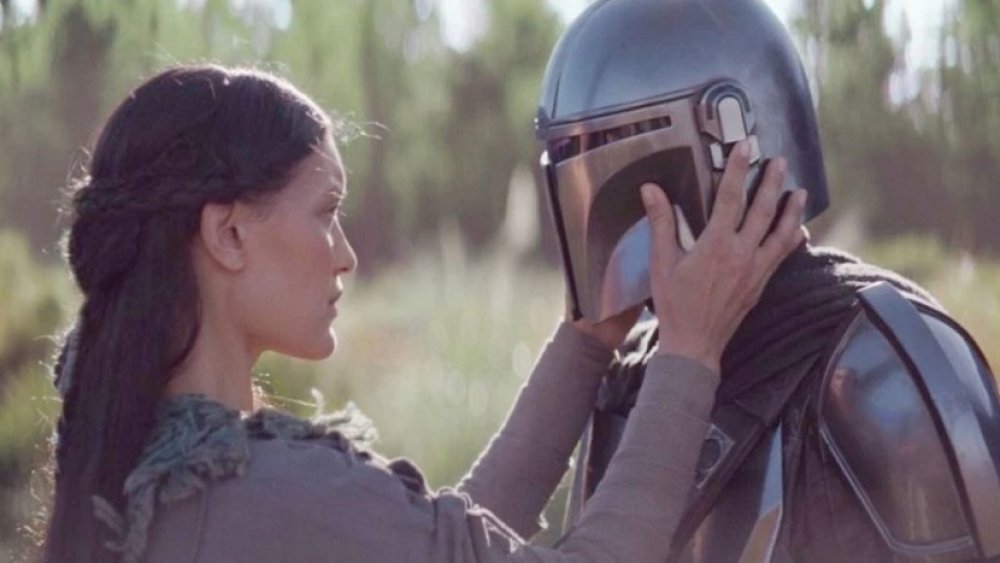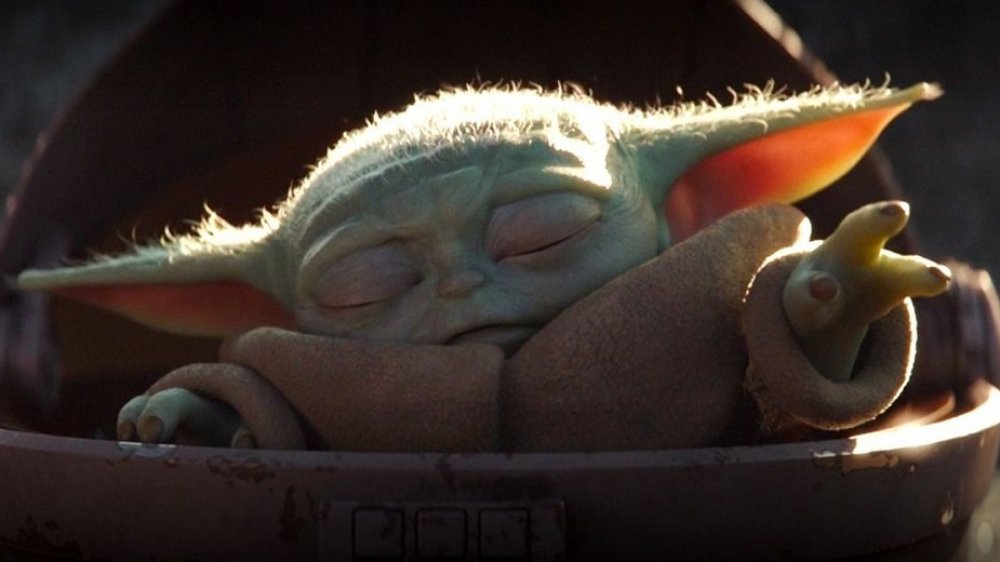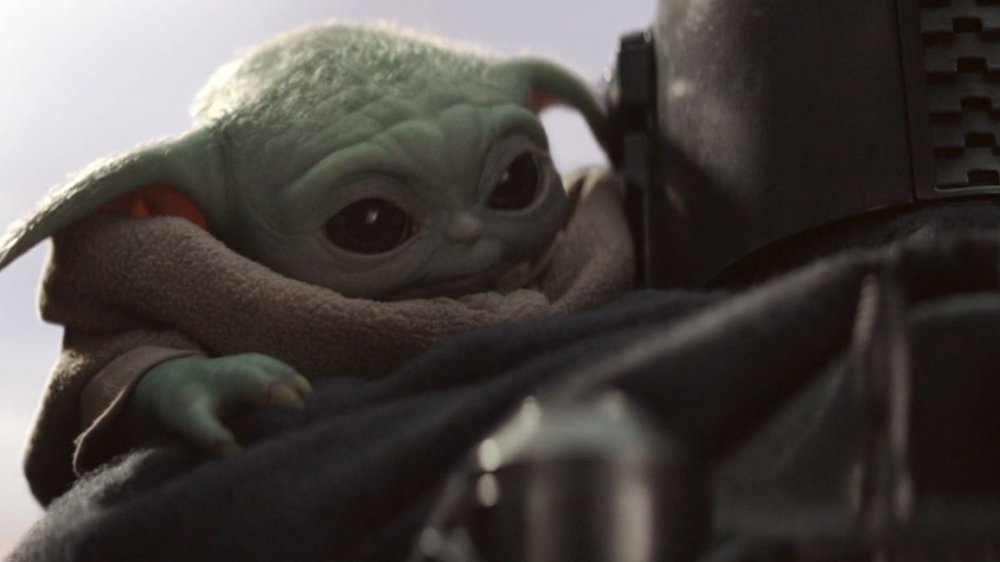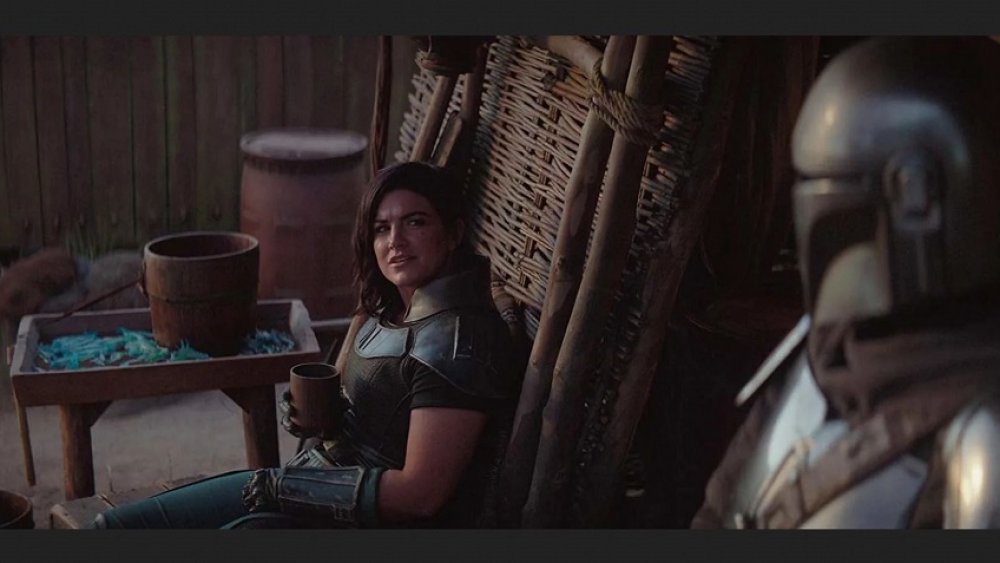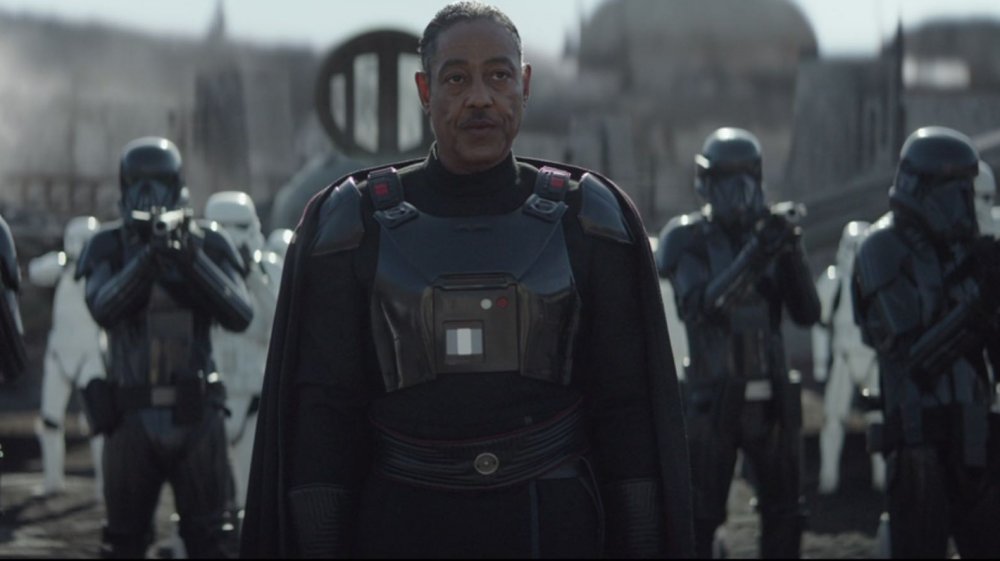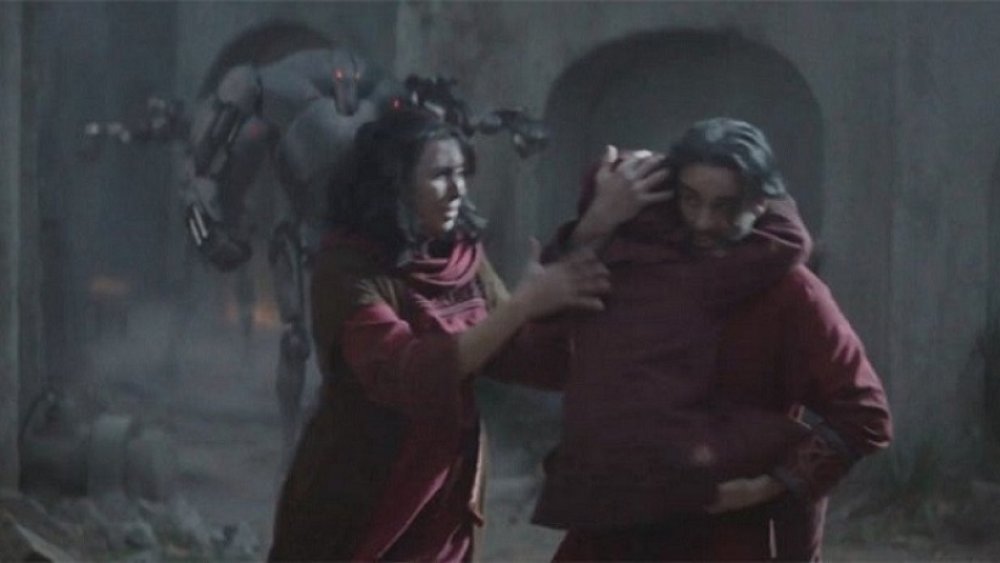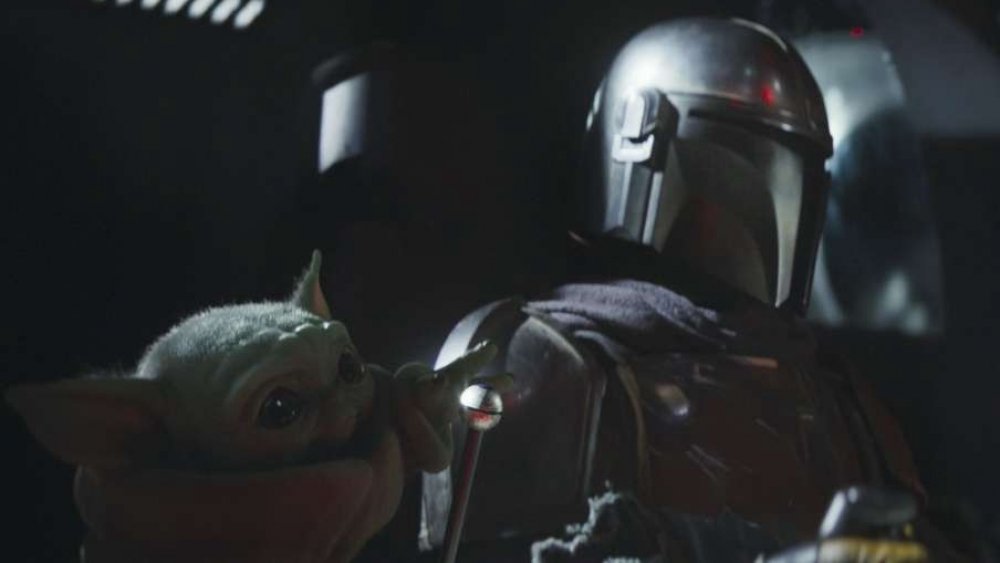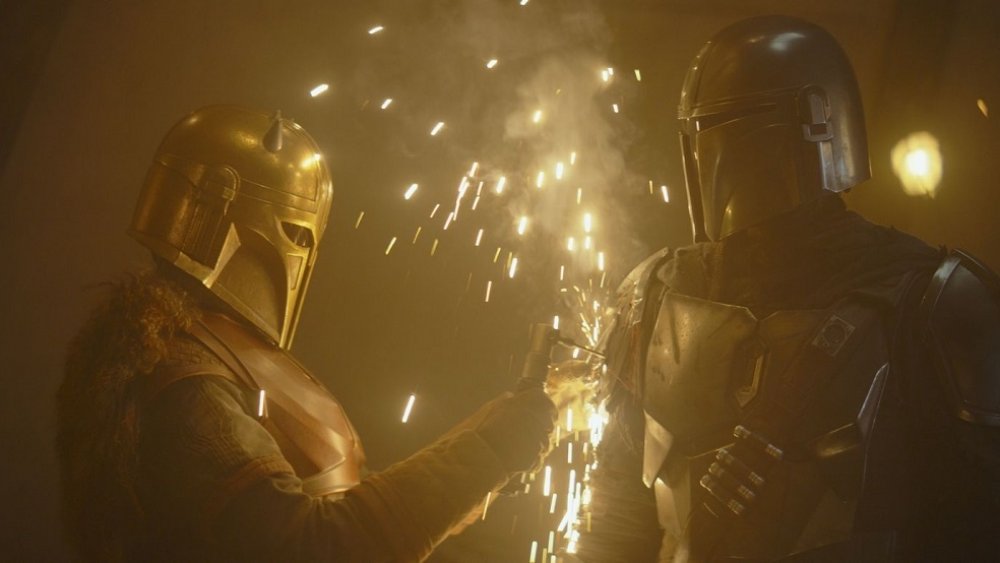Lines In The Mandalorian That Mean More Than You Realize
The Mandalorian is a bonafide hit. It's no mystery as to why: The show is loaded with gorgeous cinematography, fabulous sets, and intriguing lore. It also has excellent casting, featuring superb actors like Pedro Pascal, Ming-Na Wen, and Werner Herzog. On top of that, it's loaded with references to the original Star Wars trilogy and ancillary productions like The Clone Wars and Rebels (hello, Darksaber). And then there's the Mandalorian himself. Mandalorians have been a beloved enigma since Boba Fett's introduction in The Star Wars Holiday Special. They're resilient survivors, warrior monks, and bounty hunters with super cool gadgets — what's not to love? Pair one of those intergalactic all-stars with the hypnotically cute Child, and you've got a winning combination.
Much of The Mandalorian's success can be attributed to its fantastic group of writers. Fans do not lack for intriguingly composed lines to puzzle over as they wait for season two. Some bits of dialogue point to growing pains faced by the New Republic, while some examine defining moments in central character's lives. Still others touch on tangled backstories — AKA, fandom catnip. These are the lines from The Mandalorian worth examining a little more closely than you might have initially thought.
The title itself
Hidden meaning can be found lurking in the title of the show. At first, it appears rather self-explanatory: The main character, Din Djarin, was rescued as a child during the Clone Wars by a group of Mandalorians. Thus, he became one of them. Din's clear-cut existence is forever altered, however, when he crosses paths with the creature known only as the Child. At first, Din thinks of the creature as just another bounty, as does the audience — albiet a danged cute one, immediately christened en masse as "Baby Yoda." However, by the end of the season, the Child is no longer merely a cash cow to be exploited — he is a "foundling," in the care and protection of Din.
Such foundlings grow up to become Mandalorians, should they so choose. Being a Mandalorian isn't a race — it's a creed anyone can accept, upon coming of age. The title doesn't just refer to Din, but potentially to the Child as well.
Following the Mandalorian way
The Mandalorian's script is full of novel catchphrases — consider Kuiil's refrain, "I have spoken," which became instantly iconic. "This is the Way" is another phrase that has become a fan favorite. At first glance, it seems to be a simple affirmation Mandalorians share with one another. However, it also hearkens back to the Resol'nare, or the "Six Actions" which define the Mandalorian way of life. Initially appearing in 2006's Star Wars Insider #86, the Resol'nare tells Madalorians to wear armor, speak the Mandalorian language, be willing and able to defend themselves, raise their children as Mandalorians, contribute to the clan's welfare, and, when called upon by their leader, rally to a central cause.
The Mandalorian is deeply influenced by lore from Legends, as is most evident by the Darksaber's appearance in the season finale. "This is the Way," then, can be taken as a nod to the Resol'nare, and as carrying far more weight than a mere greeting. Hopefully, more on this will be revealed in the second season.
The matter of sin
At first, it seems like the title of the third episode, "The Sin," references Din's choice to break his word as a bounty hunter. Bounty hunters live by their own creed, an unwritten set of rules which provide a means for lawless individuals to carry out their business with a modicum of order and security. Violating this code could cause a bounty hunter to lose their hunting license, compromising their reputation and livelihood in the process. The code forbids hunters from asking about their bounties once delivered, as pointed out by the Client in the third episode. Not only does Din inquire about the Child after delivery, he violates the Code even further when he rescues the Child from the Imperials, sacrificing his position within the Guild in the process.
However, Din's worldview is first and foremost defined by being a Mandalorian. When the Child rescues Din from the mudhorn, the two become family, and Mandalorians are sworn to protect their families at all costs. This complicates the meaning of the episode's title enormously: Din's sin can be understood very differently by the two creeds that define his life.
Forging new armor
"My armor has lost its integrity," Din tells the Armorer, after returning with a camtono full of beskar, "I may need to start from the beginning." Din's armor is indeed damaged — however, he is also hinting at the underlying conflict he is experiencing after returning the Child to the Client.
A Mandalorian's armor means more than just protection from battle: It represents their sense of self. The small, diamond-shaped plate covering the heart is of particular importance, and touches on additional Star Wars lore. Known as the "Kar'ta Beskar," or "Iron Heart," this specific piece of armor represents the indomitable spirit of Mandalorians. No matter what they face, their hearts remain as strong and uncompromised as their steel.
While bounty hunters vow to never inquire about their targets, Mandalorians swear to care for abandoned children. Known as "foundlings," they are raised as part of the tribe if their families cannot be found, and are pertinent to continued Mandalorian survival. Not only does Din foul this Mandalorian tenet in turning the Child over, the Child also saved his life. Returning him to the Imperials hardly seems like the right way to repay him for that favor. Din is at a crossroads in this moment, unable to continue being both a bounty hunter and Mandalorian. He has lost his integrity, and indeed might need to start from the beginning.
Removing one's helmet
Conflict arises when other Mandalorians see the beskar plates Din earned for the Child's bounty, accusing him of working with the very people who have cast them into exile. In response to this attack on his integrity, the Armorer asks him, "Have you ever removed your helmet?" Din says he hasn't, to which she replies, "This is the Way," which the other Mandalorians echo.
This affirmation of their refusal to remove their helmets in front of others is layered with meaning. First, it suggests it's irrelevant which Mandalorian is faced in battle: All are equally imposing and skilled. Second, the anonymity provided by their helmets makes them strong. By living anonymously, they enhance their chance of survival. Next, the helmet symbolizes the universality of the Mandalorian identity. Since it's a creed one must follow, rather than a race one is born into, anyone can follow the Mandalorian way of life. Last, but certainly not least, refusing to remove the helmet signifies their readiness for defense, which is one of the Six Actions of the Resol'nare. You will never catch a Mandalorian unarmed, defenseless, or otherwise vulnerable. They're ready to fight at all times ... because they've had to be.
Help from an enemy
After Din tells the Armorer his armor is damaged beyond repair, she inquires what caused it. He tells her about the conflict with the mudhorn. In response, she offers to craft him a signet along with his new mail. Din declines: "I can't accept. It ... wasn't a noble kill. I was ... helped by an enemy." The enemy here is, of course, the Child.
There's still a lot to unravel about Mandalorian culture, including the exact significance of signets. They seem to represent a rite of passage related to armor damage, and/or an extension or branching-off of one clan into a new one. The only other Mandalorian signet seen in the show so far has been the ancient Mythosaur, representing the infamous Death Watch member who rescued Din from an untimely fate as a child.
Calling the Child an "enemy" may seem harsh, but per the bounty hunter's code Din follows, the Child is a bounty first and foremost, not a friend or ally. When the Armorer initially offers the mudhorn signet to Din, he is still conflicted about how deeply he plans to intervene in the Child's fate, which is why he feels it "[isn't] a noble kill" and can't accept commemoration of it.
The nature of value
After Din decides to honor his Mandalorian values and rescue the Child from the Imperials, he finds himself cornered by several stormtroopers. Before they all start shooting, he asks them to wait while he places the Child out of harm's way, as "what [he's] holding is very valuable." Thankfully, they acquiesce, and the audience gets to see those awesome "whistling bird" projectiles the Armorer made for him at work.
At first, it appears as though Din is speaking solely in a monetary sense, considering he's a bounty hunter holding an acquisition of massive worth. On the other hand, he is also a Mandalorian harboring an abandoned child, also known as a foundling — the new reason for his existence, and one that transcends financial riches or material gain. Once again, the audience sees these two sets of values conflict. The Child is of value for two very different reasons ... but only one truly matters, in the end.
Discontent in the New Republic
There's a gap in canon between Return of the Jedi and The Force Awakens, leaving a few decades unaccounted for Star Wars history. Cara Dune offers a little insight into these years in a conversation with Din, shortly after they first meet in the fourth episode. "Saw most of my action mopping up after Endor," she remarks, "mostly ex-Imperial warlords. They wanted it fast and quiet. They'd send us in on the drop ships. No support, just us. Then when the Imps were gone, the politics started. We were peacekeepers, protecting delegates, suppressing riots. Not what I signed up for." Cara was initially groomed for specialized missions — hunting down Imperial warlords in this case. Once the war was over, these special forces were utilized as peacekeepers, much to Cara's chagrin.
These subtle details are fascinating, and provide a very different vantage point through which to understand the events of Star Wars. It's easy to assume everyone hopped on board with the Rebellion, and the New Republic launched without a hitch. In reality, people are deeply complex creatures, and something like major political reform across multiple star systems is no simple feat. The people in Star Wars are no different. Someone like Cara was forced to transition from being one sort of person to another, and she's likely not the only one who had trouble with it.
The threat of vaporization
"Your astute panic suggests that you understand your situation," Moff Gideon says to Cara, Din, and Greef Carga in the eighth episode. He proceeds to mention characters by their full names, notes their planets of origin, and remarks upon tribulations from their past. He also notes the really big gun assembled next to him, along with its notable capabilities: An E-Web heavy repeating blaster, with the ability to vaporize pretty much anything in its path.
This is an especially chilling line for Cara. First off, she's seen fellow soldiers succumb to similar guns during the Civil War. Moreover, her home planet of Alderaan was vaporized a decade prior during the Death Star's first test of its own vaporizing weapon — right in front of another tough brunette who once called the planet home, the one and only Princess Leia. The very same kind of weapon, wielded by the same people, is once again threatening to tear apart the lives of people trying to survive. Gideon would do well to consider, however, just how motivating a factor having one's loved ones vaporized is in fomenting rebellion.
Moff Gideon's past
While staring down the barrel of the E-Web blaster, Din remarks to Cara and Greef his suspicion that "Moff Gideon was an ISB officer during the purge." The Imperial Security Bureau was formed under the direction of Galactic Emperor Palpatine as a secret police organization. You may recall them from the original trilogy, as their distinctly light-colored uniforms contrast starkly against the rest of the Imperial officers' dark palettes.
The ISB was dedicated to rooting out those considered enemies, along with maintaining stability throughout Imperial territories. They used sophisticated espionage to dismantle and suppress uprisings and freedom movements, and became even more active after the destruction of the first Death Star, which would have taken place about seven years prior. It makes sense, then, that someone of Moff Gideon's station would also be an ISB officer. His expertise in digging up information certainly explains his ability to identify people who are experts in remaining anonymous. However, if Moff Gideon is indeed an ISB officer, that means he is even scarier and more dangerous than he first appears. Our heroes would do well to tread lightly.
Enemy sorcerers
Towards the end of the season one finale, the Armorer learns of the bond between the Child and Din, and tells him he must "raise him as [his] own, until he finds his people or he takes the Creed." Din replies, incredulous, "You expect me to search the galaxy for the home of this creature and deliver it to a race of enemy sorcerers?"
Mandalorian history is rife with unrest among its people, often stemming from disagreements over the warrior code that binds their culture together. That might seem strange, given how important the Creed is — but that is, of course, why it's so heavily debated. This conflict has been exploited by the Jedi, who have been at odds with the Mandalorians for years, continually seeking to suppress their influence. This spurred the Mandalorian-Jedi War, which encompassed a series of conflicts spanning generations. After the war, the groups learned to become allies — until the Mandalorians chose to follow Order 66 under the direction of Emperor Palpatine. This top-secret order identified all Jedi as traitors to the Galactic Republic, and therefore subject to immediate execution. Jedi were literally shot in the back by people who, just moments before, they'd considered comrades-in-arms. Thus, tensions remain between the Mandalorians and the Jedi, captured succinctly in Din's upset dialogue.
A clan of two
After the Armorer helps Din understand the importance of the roles he and the Child now play in each other's lives, she finally forges Din's signet, stating they are now "a clan of two." The tragic backstory shared by the history of both their people makes the connection shared by Din and the Child that much more meaningful. Despite their differences, they are now united by their shared need for each other. When Din is initially offered this signet, he refuses because he isn't sure what part he wants to play in the Child's life. By the season finale, however, Din is ready to do whatever it takes to help raise and defend his foundling, who will remain as his until Din finds his people.
The Armorer honors their relationship by granting Din his well-earned signet, establishing them as a unit unto themselves. It's Star Wars poetry, culminating in the appearance of the Darksaber before the end credits roll. Praise The Maker! Fans will have to content themselves with poring over these lines until the next season airs, but hey, at least they're jam-packed with meaning.
